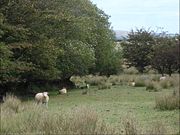
Exmoor Horn
Encyclopedia

Exmoor
Exmoor is an area of hilly open moorland in west Somerset and north Devon in South West England, named after the main river that flows out of the district, the River Exe. The moor has given its name to a National Park, which includes the Brendon Hills, the East Lyn Valley, the Vale of Porlock and ...
, Devon
Devon
Devon is a large county in southwestern England. The county is sometimes referred to as Devonshire, although the term is rarely used inside the county itself as the county has never been officially "shired", it often indicates a traditional or historical context.The county shares borders with...
, in the 19th century, but is a descendant of sheep that had roamed on the moors for several hundred years.
Research by the Exmoor National Park has found that numbers have gradually declined: it estimates that in 1947 over 27% of sheep in the Somerset
Somerset
The ceremonial and non-metropolitan county of Somerset in South West England borders Bristol and Gloucestershire to the north, Wiltshire to the east, Dorset to the south-east, and Devon to the south-west. It is partly bounded to the north and west by the Bristol Channel and the estuary of the...
part of Exmoor were pure bred Exmoor Horns. As the number of sheep in the region has increased, so the percentage has dropped, and today breeding Exmoor Horn ewes represent only about 10% of the total on Exmoor. The National Park reports that there are about 19,000 registered breeding ewes today, of which around 15,000 are on Exmoor. Small numbers are also found on neighbouring Dartmoor
Dartmoor
Dartmoor is an area of moorland in south Devon, England. Protected by National Park status, it covers .The granite upland dates from the Carboniferous period of geological history. The moorland is capped with many exposed granite hilltops known as tors, providing habitats for Dartmoor wildlife. The...
.
Exmoors are a hardy breed, so well suited to the high moors. They are ‘dual purpose’ - bred not just for their wool
Wool
Wool is the textile fiber obtained from sheep and certain other animals, including cashmere from goats, mohair from goats, qiviut from muskoxen, vicuña, alpaca, camel from animals in the camel family, and angora from rabbits....
, but also for the fact that they are prolific sheep and good mothers, producing quality lamb.
External links
- Exmoor Horn Sheep Breeders’ Society
- Exmoor Horn, Oklahoma State University, Dept. of Animal Science

